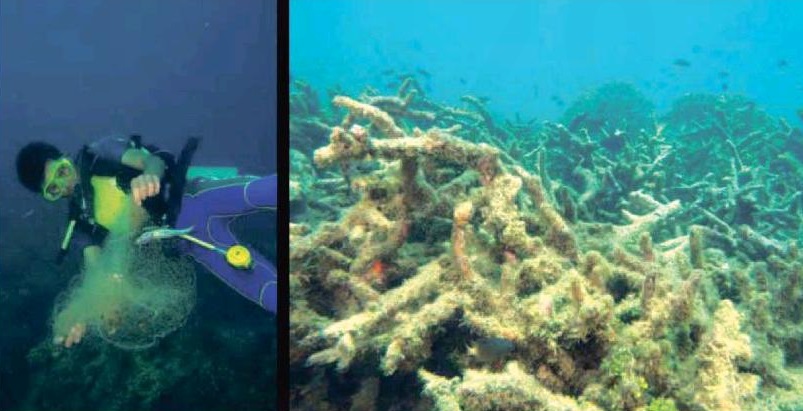
Fish nets abandoned in the sea result in the “ghost fishing”. Damaged corals are left as rubble in the seafloor of Malusay and Hilaitan, Guihulngan, Negros Oriental, observed in a September 15-22 expedition of the Tanon Strait by conservation members of Oceana.
Several coastal habitats are in poor shape in the Tañon Strait while fisheries are heavily exploited due to the encroachment of commerical fishing boats in municipal waters.
These were among the findings of a five-day expedition by Oceana Philippines from September 15 to 22.
Oceana senior scientist Jimely Flores in a press conference said that “white corals” and rubble in the seafloor of Sta. Fe, Bantayan in north Cebu were evidence of the use of cyanide and blast fishing.
Abandoned nets underwater resulted in “ghost fishing” in Malusay and Hilaitan in Guihulngan, Negros Oriental.
The team also visited Colase in Samboan town and Moabboal in south Cebu.
After five days at sea, Edward Lorenzo, Oceana’s legal and policy director, said they documented 12 commercial fishing vessels either transiting from fishing operations or engaging in actual fishing operation.
“All of the vessels are 3.1 gross tons in capacity and are all operating in Tañon Strait,” Lorenzo said.
All vessels had active fishing gear and two vessels were found to be using same name.
Most of the commercial fishing operations were being done in areas where payaos or bamboo rafts used as fish attraction devices were deployed.
The Tañon Strait between Cebu and Negros was declared a protected area in 1998 and is the biggest marine protected area in the country.
In Hagnaya port in San Remigio, Cebu, vessels with illegal “hulbot-hulbot” fear were docked.
Oceana recommended that catch monitoring be done for a baseline study of the area to find out the “carrying capacity” of the Strait.
A “science-based approached” to fisheries along with clear policies on the use and regulation of the payao is needed, said Lorenzo.
He also recommended a listing of all commercial fishing vessle based in the Tañon Strait and the harmonizing of scattered municipal fisheries ordinances.
Strategic monitoring of fishing is also needed by the Department of Environment and Natural Resources-Protected Area Office (DENR-PAO) should coordinate with Bureau of Fisheries and Aquatic Resources (BFAR-7) and other academic institutions to determine the status of fisheries.
Enforcement
BFAR-7 Regional Director Andres Bojos said that they will join hands together with other agencies to address the concerns.
Commander Agapito Bibat, incoming chief of staff of the Philippine Coast Guard (PCG) in Central Visayas said they have aluminum boats that can be used to monitor illegal fishing.
Lawyer Gloria Ramos, vice president for Oceana Philippines, said they look forward to the signing soon of implementing rules of reforms in the Fisheries Code, which includes stricter fines and the establishment of vessel monitoring mechanisms on commercial fishing vessels.